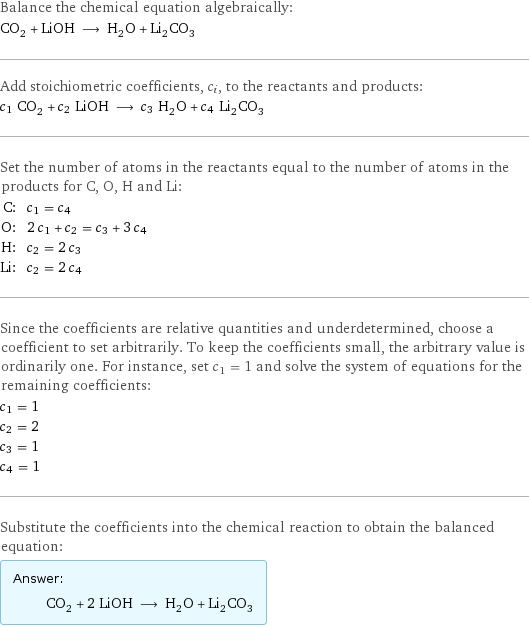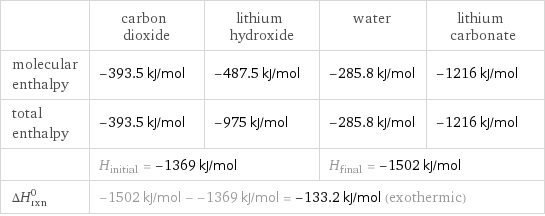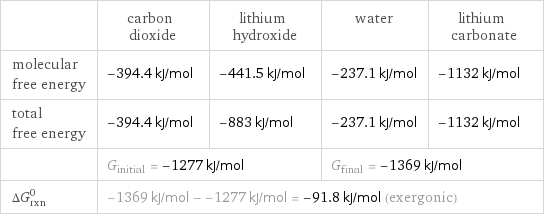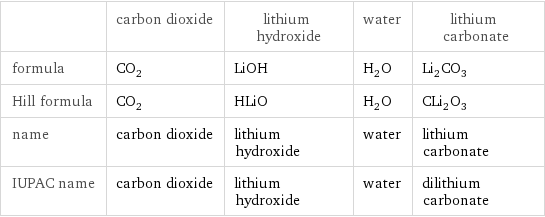Input interpretation

CO_2 carbon dioxide + LiOH lithium hydroxide ⟶ H_2O water + Li_2CO_3 lithium carbonate
Balanced equation

Balance the chemical equation algebraically: CO_2 + LiOH ⟶ H_2O + Li_2CO_3 Add stoichiometric coefficients, c_i, to the reactants and products: c_1 CO_2 + c_2 LiOH ⟶ c_3 H_2O + c_4 Li_2CO_3 Set the number of atoms in the reactants equal to the number of atoms in the products for C, O, H and Li: C: | c_1 = c_4 O: | 2 c_1 + c_2 = c_3 + 3 c_4 H: | c_2 = 2 c_3 Li: | c_2 = 2 c_4 Since the coefficients are relative quantities and underdetermined, choose a coefficient to set arbitrarily. To keep the coefficients small, the arbitrary value is ordinarily one. For instance, set c_1 = 1 and solve the system of equations for the remaining coefficients: c_1 = 1 c_2 = 2 c_3 = 1 c_4 = 1 Substitute the coefficients into the chemical reaction to obtain the balanced equation: Answer: | | CO_2 + 2 LiOH ⟶ H_2O + Li_2CO_3
Structures

+ ⟶ +
Names

carbon dioxide + lithium hydroxide ⟶ water + lithium carbonate
Reaction thermodynamics
Enthalpy

| carbon dioxide | lithium hydroxide | water | lithium carbonate molecular enthalpy | -393.5 kJ/mol | -487.5 kJ/mol | -285.8 kJ/mol | -1216 kJ/mol total enthalpy | -393.5 kJ/mol | -975 kJ/mol | -285.8 kJ/mol | -1216 kJ/mol | H_initial = -1369 kJ/mol | | H_final = -1502 kJ/mol | ΔH_rxn^0 | -1502 kJ/mol - -1369 kJ/mol = -133.2 kJ/mol (exothermic) | | |
Gibbs free energy

| carbon dioxide | lithium hydroxide | water | lithium carbonate molecular free energy | -394.4 kJ/mol | -441.5 kJ/mol | -237.1 kJ/mol | -1132 kJ/mol total free energy | -394.4 kJ/mol | -883 kJ/mol | -237.1 kJ/mol | -1132 kJ/mol | G_initial = -1277 kJ/mol | | G_final = -1369 kJ/mol | ΔG_rxn^0 | -1369 kJ/mol - -1277 kJ/mol = -91.8 kJ/mol (exergonic) | | |
Equilibrium constant
![Construct the equilibrium constant, K, expression for: CO_2 + LiOH ⟶ H_2O + Li_2CO_3 Plan: • Balance the chemical equation. • Determine the stoichiometric numbers. • Assemble the activity expression for each chemical species. • Use the activity expressions to build the equilibrium constant expression. Write the balanced chemical equation: CO_2 + 2 LiOH ⟶ H_2O + Li_2CO_3 Assign stoichiometric numbers, ν_i, using the stoichiometric coefficients, c_i, from the balanced chemical equation in the following manner: ν_i = -c_i for reactants and ν_i = c_i for products: chemical species | c_i | ν_i CO_2 | 1 | -1 LiOH | 2 | -2 H_2O | 1 | 1 Li_2CO_3 | 1 | 1 Assemble the activity expressions accounting for the state of matter and ν_i: chemical species | c_i | ν_i | activity expression CO_2 | 1 | -1 | ([CO2])^(-1) LiOH | 2 | -2 | ([LiOH])^(-2) H_2O | 1 | 1 | [H2O] Li_2CO_3 | 1 | 1 | [Li2CO3] The equilibrium constant symbol in the concentration basis is: K_c Mulitply the activity expressions to arrive at the K_c expression: Answer: | | K_c = ([CO2])^(-1) ([LiOH])^(-2) [H2O] [Li2CO3] = ([H2O] [Li2CO3])/([CO2] ([LiOH])^2)](../image_source/c843ac57b0767610169ad27fa69ee101.png)
Construct the equilibrium constant, K, expression for: CO_2 + LiOH ⟶ H_2O + Li_2CO_3 Plan: • Balance the chemical equation. • Determine the stoichiometric numbers. • Assemble the activity expression for each chemical species. • Use the activity expressions to build the equilibrium constant expression. Write the balanced chemical equation: CO_2 + 2 LiOH ⟶ H_2O + Li_2CO_3 Assign stoichiometric numbers, ν_i, using the stoichiometric coefficients, c_i, from the balanced chemical equation in the following manner: ν_i = -c_i for reactants and ν_i = c_i for products: chemical species | c_i | ν_i CO_2 | 1 | -1 LiOH | 2 | -2 H_2O | 1 | 1 Li_2CO_3 | 1 | 1 Assemble the activity expressions accounting for the state of matter and ν_i: chemical species | c_i | ν_i | activity expression CO_2 | 1 | -1 | ([CO2])^(-1) LiOH | 2 | -2 | ([LiOH])^(-2) H_2O | 1 | 1 | [H2O] Li_2CO_3 | 1 | 1 | [Li2CO3] The equilibrium constant symbol in the concentration basis is: K_c Mulitply the activity expressions to arrive at the K_c expression: Answer: | | K_c = ([CO2])^(-1) ([LiOH])^(-2) [H2O] [Li2CO3] = ([H2O] [Li2CO3])/([CO2] ([LiOH])^2)
Rate of reaction
![Construct the rate of reaction expression for: CO_2 + LiOH ⟶ H_2O + Li_2CO_3 Plan: • Balance the chemical equation. • Determine the stoichiometric numbers. • Assemble the rate term for each chemical species. • Write the rate of reaction expression. Write the balanced chemical equation: CO_2 + 2 LiOH ⟶ H_2O + Li_2CO_3 Assign stoichiometric numbers, ν_i, using the stoichiometric coefficients, c_i, from the balanced chemical equation in the following manner: ν_i = -c_i for reactants and ν_i = c_i for products: chemical species | c_i | ν_i CO_2 | 1 | -1 LiOH | 2 | -2 H_2O | 1 | 1 Li_2CO_3 | 1 | 1 The rate term for each chemical species, B_i, is 1/ν_i(Δ[B_i])/(Δt) where [B_i] is the amount concentration and t is time: chemical species | c_i | ν_i | rate term CO_2 | 1 | -1 | -(Δ[CO2])/(Δt) LiOH | 2 | -2 | -1/2 (Δ[LiOH])/(Δt) H_2O | 1 | 1 | (Δ[H2O])/(Δt) Li_2CO_3 | 1 | 1 | (Δ[Li2CO3])/(Δt) (for infinitesimal rate of change, replace Δ with d) Set the rate terms equal to each other to arrive at the rate expression: Answer: | | rate = -(Δ[CO2])/(Δt) = -1/2 (Δ[LiOH])/(Δt) = (Δ[H2O])/(Δt) = (Δ[Li2CO3])/(Δt) (assuming constant volume and no accumulation of intermediates or side products)](../image_source/e67984580eaed4267af54c6c8df02c41.png)
Construct the rate of reaction expression for: CO_2 + LiOH ⟶ H_2O + Li_2CO_3 Plan: • Balance the chemical equation. • Determine the stoichiometric numbers. • Assemble the rate term for each chemical species. • Write the rate of reaction expression. Write the balanced chemical equation: CO_2 + 2 LiOH ⟶ H_2O + Li_2CO_3 Assign stoichiometric numbers, ν_i, using the stoichiometric coefficients, c_i, from the balanced chemical equation in the following manner: ν_i = -c_i for reactants and ν_i = c_i for products: chemical species | c_i | ν_i CO_2 | 1 | -1 LiOH | 2 | -2 H_2O | 1 | 1 Li_2CO_3 | 1 | 1 The rate term for each chemical species, B_i, is 1/ν_i(Δ[B_i])/(Δt) where [B_i] is the amount concentration and t is time: chemical species | c_i | ν_i | rate term CO_2 | 1 | -1 | -(Δ[CO2])/(Δt) LiOH | 2 | -2 | -1/2 (Δ[LiOH])/(Δt) H_2O | 1 | 1 | (Δ[H2O])/(Δt) Li_2CO_3 | 1 | 1 | (Δ[Li2CO3])/(Δt) (for infinitesimal rate of change, replace Δ with d) Set the rate terms equal to each other to arrive at the rate expression: Answer: | | rate = -(Δ[CO2])/(Δt) = -1/2 (Δ[LiOH])/(Δt) = (Δ[H2O])/(Δt) = (Δ[Li2CO3])/(Δt) (assuming constant volume and no accumulation of intermediates or side products)
Chemical names and formulas

| carbon dioxide | lithium hydroxide | water | lithium carbonate formula | CO_2 | LiOH | H_2O | Li_2CO_3 Hill formula | CO_2 | HLiO | H_2O | CLi_2O_3 name | carbon dioxide | lithium hydroxide | water | lithium carbonate IUPAC name | carbon dioxide | lithium hydroxide | water | dilithium carbonate
Substance properties

| carbon dioxide | lithium hydroxide | water | lithium carbonate molar mass | 44.009 g/mol | 23.95 g/mol | 18.015 g/mol | 73.9 g/mol phase | gas (at STP) | solid (at STP) | liquid (at STP) | solid (at STP) melting point | -56.56 °C (at triple point) | 462 °C | 0 °C | 618 °C boiling point | -78.5 °C (at sublimation point) | | 99.9839 °C | density | 0.00184212 g/cm^3 (at 20 °C) | 1.46 g/cm^3 | 1 g/cm^3 | 2.11 g/cm^3 surface tension | | | 0.0728 N/m | dynamic viscosity | 1.491×10^-5 Pa s (at 25 °C) | | 8.9×10^-4 Pa s (at 25 °C) | odor | odorless | odorless | odorless |
Units
